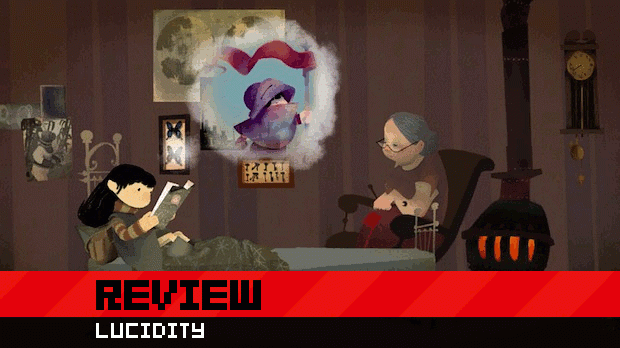Revealed September 10th on an episode of GTTV after weeks of rumors, Lucidity is developer LucasArts’ new downloadable title. Unlike their last few releases like Secret of Monkey Island: Special Edition or Loom, Lucidity is an original IP. More importantly, it was built from the ground up internally at the studio.
Rich in color and style, and possessing a haunting soundtrack, the downloadable isn’t rough on the ear- or eyeholes. But, of course, how a game feels or looks isn’t the most important factor. The action is. So, does Lucidity work?
Hit the break for the full review to find out.

Lucidity (Steam, Xbox LIVE Arcade [reviewed])
Developed by: LucasArts
Published by: LucasArts
Released: October 1, 2009
MSRP: 800 Microsoft Points, $10.00
Lucidity is an odd bird. Its graceful, almost hidden narrative succeeds in invoking emotion left otherwise unprovoked by its visual elegance. But the game fails on a fundamental level, serving as a case in point that rich art and good, thoughtful narrative can’t hide or replace solid mechanics. Just like a glorious cover hides a bad book, this game’s innards are fractured and mashed underneath its colorful and inspired look.
Laced with intelligent goodies, the silent narrative delivers with a speedy exploration of the basic plot and characters. At the beginning of the game, we see the innocent Sofi in bed dreaming of adventuring through an ocean inferno, a lush jungle and another set-piece location. Her grandmother sits in a chair adjacent to the bed, rocking back and forth while fussing with yarn. She looks over the young one, conjuring an instant image of the ancient as the protector, but all is not well.
In general, this is expressed through the melancholy that permeates through the game’s look and sound, in addition to scraps of writing shown after a level and during the game’s loading screens. Sofi retrieves a postcard from her grandmother post-level completion. The cards are a simple, sweet, and comforting gesture that goes a long way in terms of the giving emotional impact. Furthering this are Sofi’s diary entries, which show her internalization of the things she’s experiencing on her journey.

Sofi as the young and innocent is expressed well through the core mechanics. The girl moves headlong into environments without a controller’s aid. Thus, the task at hand is to guide Sofi and become her protector via a woefully simplistic object selection system.
Phantom Fans, horizontal cuts of wood, slingshots, shoes loaded with springs, and even bombs are used to help the ever-moving Sofi through the dangerous settings. Appealing on its face, there’s a rough catch to this reverse platformer design: a mere two objects can be switched between at a time, and those two objects are randomly determined by a broken mechanism.
The levels are full of dangerous pits and enemies, and they must be avoided through the use of ideal objects at ideal times. Unfortunately, this almost never happens. Instead, players are forced to use a chaotic mess of items to propel Sofi past hazards. Where a stairway would be sufficient, for example, the player must instead use a fan, a block, and then spring shoes to move over a simple spiky pit. This causes a variety of issues as Sofi treads through levels and leads to numerous unavoidable, face-puckering deaths as one chaotic solution leads to a series of chaotic solutions.
The fail states are the worst. In the later levels, a nightmarish blackness envelops, acting as a timer of sorts and pushing the tempo of item placement. If Sofi gets stuck on a wall and the correct item can’t be utilized quickly enough, the game is over. This, is in addition to the slow movement that using less-than-ideal objects causes, induces rage.
And again, adding to this are the convoluted levels that feature too many joints and sticking points, along with confusing and much-too-dangerous passageways
Death, death, and more death. Always unavoidable death. While the item selection system is poor, the game isn’t wholly unplayable. In my estimation, the game dishes the rough equivalent of an ideal object around 60 percent of the time. The problem with using rough equivalents is that they aren’t the precise solution — Sofi may make it over a corner or through a wall through abstract means, but without the slingshot, she’ll fall in the next pit regardless.

The game does have its bright spots, but they are all within systems the player doesn’t use to play the game. The thoughtful story and rich art are lost in the chaos of the object selection system. Lacking the intuitiveness that the game demands, Lucidity is a product that feels incomplete, despite the polish on the visuals. Perhaps with a patch the system can be salvaged, but until then, it’s best to steer away.
Score: 4.5 — Below Average (4s have some high points, but they soon give way to glaring faults. Not the worst games, but are difficult to recommend.)






Published: Oct 12, 2009 09:30 pm